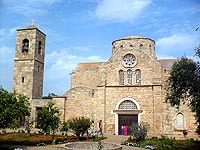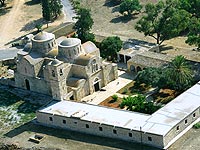
Monastery of St Barnabas in Famagusta, North Cyprus.
 |
the north cyprus travel guide |
 |
|
St. Barnabas Monastery
|
 St Barnabas Monastery photo by: Matthew Hoskin [ enlarge photo ] |
The Monastery of St Barnabas, Famagusta, North Cyprus
The monastery of St Barnabas was founded on the site of the apostle Barnabas, and is a reminder of the important role Cyprus played in the history of Christianity in the Mediterranean.
St Barnabas of Cyprus
Barnabas was born in Salamis, and joined the apostle Paul to spread the Gospel through Cyprus and Asia Minor. However, the two men split up over the objection to Barnabas's cousin Mark coming along too. In AD 75, the Jewish community in Salamis objected to his missionary work, and had Barnabas stoned to death. Mark rescued his cousin's body and buried it at a secret location.
 St Barnabas Monastery Video video by: TRNC Ministry of Tourism [ play video ] |
St Barnabas in North Cyprus; more influential dead than alive?
In the fifth century, the Church of Antioch tried to rule it over the church already established on Cyprus. The Cyprus church defended itself by claiming that since it was founded by a saint, it was equal in rank to the Church of Antioch, founded by Saint Paul. Problem was, there was no proof of this, until St Barnabas appeared in a vision to the Archbishop in AD477 and directed his to Barnabas' tomb. The Archbishop found the tomb exactly where the vision had indicated, complete with a skeleton clutching a copy of the Gospel of St Matthew, and so the Cyprus church was awarded special privileges.
The monastery of St Barnabas, North Cyprus
The monastery was established on the site of the saints tomb in the fifth century, with funds provided by the Byzantine emperor. However, the church was destroyed by Arab raiders in the seventh century, but it was rebuilt. The present church and cloisters at the monastery of St Barnabas, North Cyprus date from 1756, and parts of the building reuse columns from the ancient site at Salamis.
 St Barnabas Monastery from Air photo by: TAK News Agency [ enlarge photo ] |
The three brothers of St Barnabas Monastery, North Cyprus
Right up until 1974, the monastery of St Barnabas, North Cyprus, was a favourite place for Famagustans to have their babies baptised, the ceremonies conducted by three monks, all brothers. The brothers restored the belfry in 1958, and financed the monastery’s restoration and repairs themselves through selling honey and their home-painted icons. However, in 1976, the stress proved too much for the old monks, and they moved to south Cyprus and the monastery at Stavrovouni.
Today, the monastery of St Barnabas welcomes visitors, and many of its rooms are now part of the St Barnabas Icon and Archaeology Museum. You can still see the pulpits and lecterns in the church, which also houses the museum’s icons. For a cool break, there is a small café in the pretty gardens where one fruit tree hybridised over the years is said to produce oranges, lemons and mandarins all from the same tree.
The tomb of St Barnabas, Famagusta, North Cyprus
The tomb of St Barnabas discovered by the Archbishop is still on site, a catacomb cut down into the rock consisting of two chambers. Walk into the modern mausoleum built over the top, and down the steps into the two small chambers, originally designed to hold six dead bodies apiece. The tomb of St Barnabas, North Cyprus is far older than Christianity itself, so like the nearby rock tombs of the Cellarga, the tomb was probably reused to house the remains of the saint. Nowadays, the faithful, from both North and south Cyprus leave offerings and candles here.
| PARTNERS |





 Advertise on this site
Advertise on this site
|
North Cyprus quick: holidays | flights | hotels | property | kyrenia | famagusta | photos | map | weather | history | news
All text is copyrighted by Cyprus44. Photographs are copyrighted by their respective photographers.
For more information read our copyright policy, privacy policy and disclaimer.
This web page is served on 17 September 2025 at 12:52:01 AM.
![]()
Cyprus44 in other languages: Nordzypern | Chypre Nord | Severní Kypr | Северный Кипр
partner sites: goNorthCyprus Travel | Pacific Rent-A-Car | Amy Holiday Villas | other partner sites

